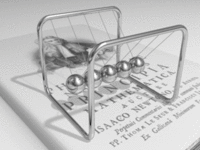Conservation of Momentum
Momentum is simply the
mass of an object times the velocity the object is
traveling. The conservation of momentum and energy is
derived from Newton’s Second and Third Laws. The second
law states that force equals mass times acceleration. The
third law states that every action has an equal and
opposite reaction. But in order to understand Newton’s
Third Law in momentum, note that this is another way to
interpret Newton's Third Law:
m1a1=-m2a2[4],
Where m1
and m2 are
the masses of the objects and a1
and a2
are the accelerations of the object. Recall acceleration
is the change in velocity over time. Using this fact and
Newton's Third Law, we may derive a new equation:
|
|
m1(dv1/dt)= |
|
m2(dv2/dt) |
|
|
m1dv1= |
|
m2dv2 |
|
vf1 |
|
vf2 |
|
|
⌠ |
m1dv1 = |
⌠ |
-m2dv2 |
|
vi1 |
|
vi2 |
|
|
|
m1(vf1-vi1)= |
|
-m2(vf2-vi2) |
|
|
m1vf1+m2vf2= |
|
m1vi1+m2vi2 |
So what does this
tell us about momentum? I'll tell you what this says: momentum
is always conserved at point of contact! If two
objects happen to collide into each other, any momentum that
is lost by one object will be absorbed by the other. The sum
of the final momentum of two objects will equal the sum of the initial momentum of the same
objects.

(Newton's cradle is a perfect example of conservation of energy. As the ball(s) make contact with other ball(s), the energy from the first ball(s) are transferred to the other ball(s), which in turn causes the ball(s) at rest to move back with an equal and opposite force.)
© CssTemplateHeaven | Created by Dieter Schneider 2006 | Valid Xhtml 1.0 Strict!